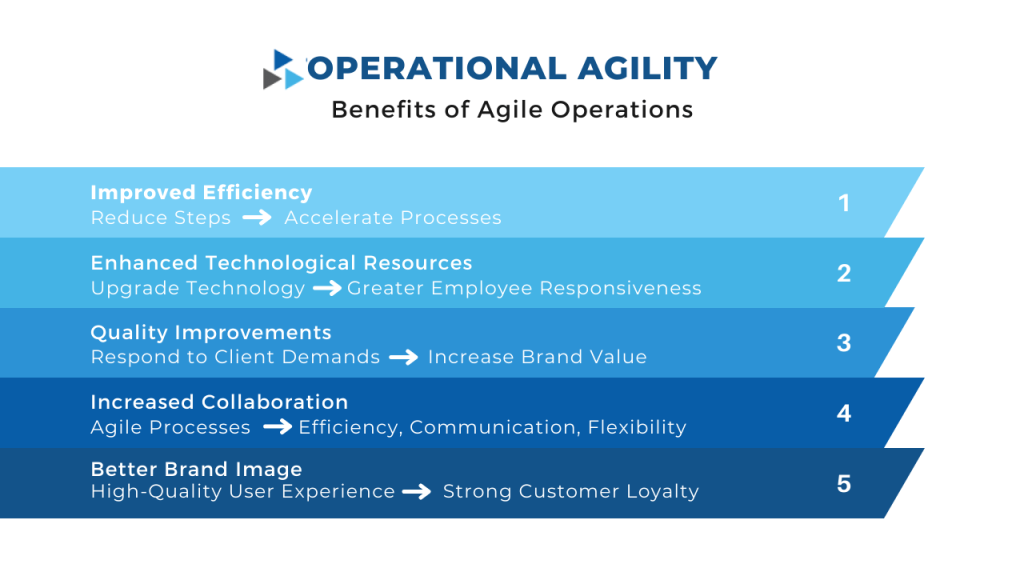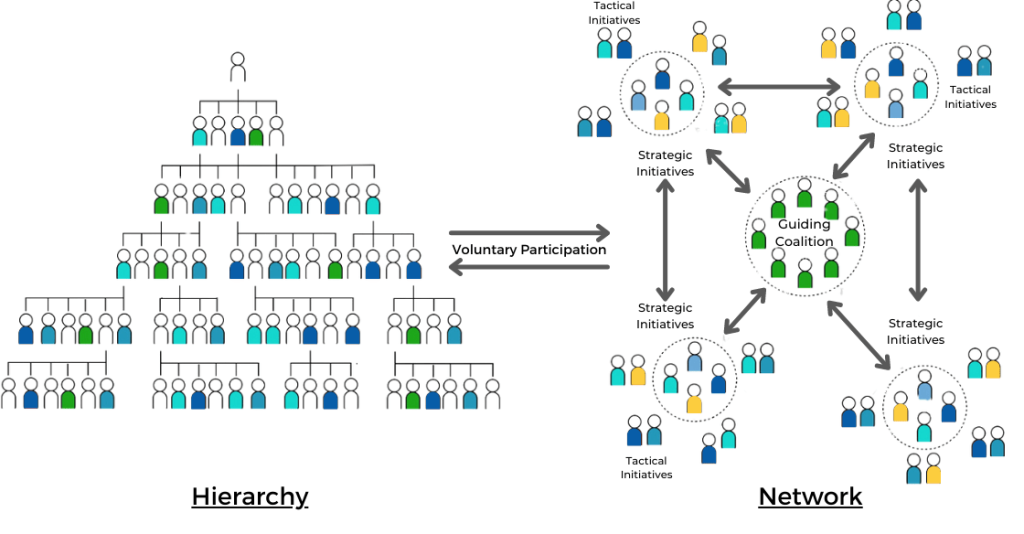The Age of Operational Agility in 2021
In the ultra-competitive modern marketplace, the companies that thrive have mastered the art of operational agility. Conversely, those organizations that fade into obscurity have a static business model and rigid internal structure. These businesses cannot adapt to the changing economic tides or unpredictable market conditions. These hard truths were highly evident during the height of the coronavirus pandemic.
While thousands of businesses learned some tough lessons during 2020, these challenges paved the way for 2021 to become the age of operational agility. With that being said, you must understand how agile operations work to prepare your organization to remain competitive in the future.
Below, we’ll discuss the core aspects of operational agility and agile working methods. Here is what you’ll learn:

What is Operational Agility?
Generally speaking, operational agility refers to an organization’s ability to adapt and evolve due to changing circumstances or expectations. Agility may include reacting to market pressures, technological advancements, changing customer demands, and more.
An agile company in operations management will be more resilient to external market factors.
While agile operations are always essential to a company’s overall financial health, it is imperative in strained economic times. This is because organizations must contend with their competitors and unpredictable operational disruptions across every industry.
Operational Agility During COVID-19
The COVID-19 pandemic is one of the most significant disruptions to the U.S. and global economy ever encountered. According to the Federal Reserve Bank of St. Louis’ Economic Research, the Index of Industrial Production demonstrated a 17% drop between February and April of 2020. The decrease was the single steepest two-month decline in the history of the IP, which was created in 1919.
The severe economic impact of the coronavirus epidemic caused many leading organizations to reevaluate their level of agile operations readiness. According to a Harvard Business Review report, a staggering 91% of organizations altered their existing operating models in response to COVID-19.
Despite these widespread disruptions, the most successful organizations effectively adapted during the pandemic’s height.
Based on the same HBR analysis, only 27% of companies stated that their strategies were “very effective” both before and after the start of the pandemic. This means that roughly 73% of organizations were at least partially unprepared to pivot their current business operations in response to COVID-19 related disruptions.
While both the U.S. and the overall global economy are on the mend, businesses should not forget the lessons learned during the pandemic. Instead, companies should take a proactive approach to long-term operational agility.
By evolving your current business model, you can ensure your company is better prepared for the next event that changes how they interact with consumers.

Benefits of Operational Agility
In addition to making a company more fiscally viable in the unpredictable modern marketplace, a high level of operational agility offers several other benefits, including:
Improvements in Efficiency
Agile operations will inherently become more efficient, as well. Each improvement that an organization makes to its current organizational structures will reduce waste and expedite internal processes.
Agile teams across various departments will share information more effectively and collaborate with ease with this approach. Operational agility will allow them to develop new solutions to emerging problems rapidly.
Enhanced Technological Resources
Organizations that deploy an agile operating model will make a concerted effort to obtain the latest digital technologies and products. While reassessing their current practices, many businesses find that the technologies they rely on are due for an upgrade. With an agile approach, they will seek new technologies that allow greater employee responsiveness.
Quality Improvements
The modern consumer has lofty expectations regarding the products and services they pay for. This same trend has arisen in the B2B industry, as well. Therefore, all organizations must become responsive to changing client demands. If a company fails to make regular quality improvements, it may lose loyal customers to its local competitors.
By achieving a high level of agile operations readiness, companies can ensure that they provide their clients with the ideal mix of quality and value.
Increased Collaboration
Collaboration is essential as organizations face new and unprecedented challenges. However, companies that lack operational agility will not have the processes to facilitate this collaboration.
Conversely, companies that have struck the perfect balance between efficiency, communication, and flexibility by deploying the latest solutions will facilitate a high level of collaboration.
Better Brand Image
Ultimately, a company’s ability to exhibit operational agility will directly impact the experience of its end users. Organizations that have invested in new technologies and solutions to increase their agility will provide their clients with a high-quality experience. In turn, this will benefit their brand image and forge a strong sense of loyalty among consumers.
Brand loyalty is essential to a company’s survival, especially during times of economic turmoil.
Fuels Innovation
In addition, operational agility gives team members the tools they need to devise creative solutions to new problems. This freedom to collaborate, share data, and think outside of the box will fuel innovation.
With an agile approach, companies will address short-term concerns and craft long-lasting initiatives simultaneously. They will be better positioned to stay competitive both now and in the future.
Operational Agility vs. Business Agility
Often, the terms operational agility and business agility are mistakenly used interchangeably. While these two terms are closely linked, they are not the same.
According to the Agile Business Consortium, “business agility is concerned with adopting and evolving values, behaviors, and capabilities. These enable businesses and individuals to be more adaptive, creative, and resilient when dealing with complexity, uncertainty, and change leading to improved well-being and better outcomes.”
While business agility focuses on the values and culture, operational agility is more concerned with the strategic deployment of technology to capitalize on new opportunities. Agile operations fall under the larger umbrella of business agility.
Both concepts are designed to help make a business more resilient to unpredictable market changes. In addition, companies must actively work to become more competent in both areas to achieve sustainable success and remain competitive in the modern marketplace.
A company that has adopted an agile operating model has deployed new solutions to improve the overall flexibility of the organization’s core operations. These solutions may include investing in cutting-edge software and increasing the interoperability of existing technologies by using API integrations.
Companies with a high level of operational agility have zeroed in on specific opportunities to improve internal processes.
Can a Company Achieve Both?
Yes, companies can achieve a high level of business and operational agility. However, doing so will require a cohesive strategy and a concerted effort amongst all operations teams.
To strive towards both goals simultaneously, an organization must take a top-down approach. Thought leaders should pave the way for these organizational changes by identifying current shortcomings and devising unique solutions.
However, the company must also encourage employee buy-in by conveying the benefits of an agile operating model. An organization seeking to implement these changes must strategically invest in innovative solutions and applications that revolutionize its existing business model.
What Are the Dual Operating Systems of Organization Agility?
The phrase “dual operating system” was coined by Dr. John Kotter in his book “XLR8” (Accelerate). In the book, he explains how most traditional organizations use a single hierarchy or “operating system.” He then highlights the limitations of this singular approach and discusses why organizations should use a dual operating system strategy.
By introducing a secondary system, Kotter theorizes that organizations can fuel innovation while simultaneously leveraging the inherent stability of a traditional hierarchy.
In Kotter’s system, the first operating system functions as a standard bureaucracy. This operating system can best be described as a pyramid, with each team member reporting to their direct supervisor in the tier above them.
The second operating system is designed more like an open chat room or network, with each individual free to communicate with whomever they wish. This operating system does not contain the standard corporate rules and regulations that inhibit sharing new ideas.
When used together, these dual operating systems facilitate optimal collaboration without giving way to utter chaos. The dual operating system approach can be a valuable tool for an organization to improve its operational agility.

How Leaders Can Be Agile in Operation Management
While every employee will play a role in an organization’s efforts to increase its agility, the onus falls on leadership to implement these changes.
For leaders to become agile in operation management, they must:
Determine Your Agile Operations Readiness
Operational readiness is a core tenet of project management. According to the Project Management Institute, operational readiness can be described as a “state that is moved toward incrementally by performing tasks and creating deliverables throughout the Project Life Cycle.”
Before leaders can deploy an agile operating model, they must ensure that their organization is at a high state of operational readiness. This preparation means investing in and deploying resources per their overarching strategy, which brings us to our next point.
Develop an Agile Operating Model & Strategy
When creating an agile operating model, leaders must address every facet of the organization. Otherwise, they will not be able to achieve operational agility.
A comprehensive agile strategy should include tactics to improve processes, technology, people, and structure.
While organizations must include the above components in their strategy, there are multiple paths to operational agility. Some companies exhibit agile practices from their inception. This is especially common among emerging businesses in the tech space due to the nature of the industry.
However, other organizations start their journey to becoming agile after having an established customer base. These companies have several options available. Some choose to go all-in, whereas others implement agile principles systematically.
The right approach for your organization will depend on several factors; the size of your company and the number of resources at your disposal.
Emerging Software and Operational Agility
Emerging software is aiding organizations as they strive to develop agile operations. Artificial intelligence (AI) has proven particularly useful for companies struggling to address operational inefficiencies.
Businesses that are more effective at leveraging the latest AI solutions are better equipped to handle unforeseen obstacles that may disrupt their workflows.
In addition to AI, the Quickbase platform offers an incredible mix of efficiency, flexibility, and value to companies that need to become more agile. Trinity offers tailor-made solutions based around the Quickbase platform. We can efficiently automate workflows, facilitate better collaboration, and consolidate your data in one secure place with agile software development.
When paired with the expertise of Trinity’s development teams, the Quickbase platform is the ultimate catalyst for improved operational agility.


Preparing Your Operations for 2022
As businesses gear up for 2022, they must place operational agility on their top priority list. Doing so will ensure that they are better prepared to rebound from the last two years while achieving lasting growth.
The businesses that want to adopt an agile operating model will need to devise a cohesive plan. Company leadership should also prepare staff members for the implementation of agile methodology. Together, these two tactics will facilitate a more seamless transition.
However, no agile operating strategy is complete without a complementary suite of technologies. Fortunately, Trinity can help with our Quickbase software solutions.
Whether your organization is implementing agile strategies for the first time or simply wants to improve upon your current practices, Trinity can help. We can give you the capabilities to manage your data and assets, centralize information, encourage seamless collaboration, and increase operational security.
If you want to learn more and improve your business, contact Trinity today!
